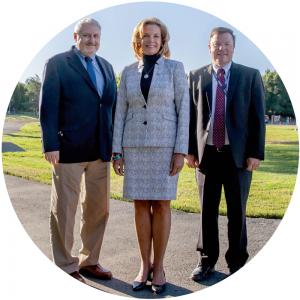Positioning the Laboratory for continuing excellence in science and technology directed at important national missions
FY 2019 was a year focused on engaging with stakeholders and sponsors, providing technical leadership in key mission areas, and building for future successes.
Strategic Engagements and Leadership
In August 2019, DOE Under Secretary for Nuclear Security and NNSA administrator Lisa Gordon-Hagerty came to Livermore, along with other distinguished guests, to attend a series of events celebrating past accomplishments and NNSA's high-performance computing (HPC) future. The under secretary also accompanied U.S. Secretary of Energy Rick Perry in a subsequent visit to launch a public–private partnership for applying DOE's HPC resources and machine-learning capabilities to fight neurological disorders (see Neurotechnologies Monitor the Brain). These and many other engagements by Laboratory programmatic and technical leaders with key stakeholders are vital to understanding stakeholders' needs, sharing LLNL expertise, and helping to shape the evolving strategic landscape.
LLNL is providing the nation with technical leadership in many facets of its national security mission. Livermore is engaged in two nuclear warhead modernization programs and is leading a multilaboratory effort to improve early detection of nuclear proliferation activities. With the W87-1 modification program, Livermore is helping to bring modern manufacturing processes into the NNSA nuclear enterprise, and the Laboratory is at the forefront of NNSA's efforts to modernize infrastructure life-cycle management. Other examples of programmatic and technical leadership, such as in HPC, are described elsewhere in this annual report.
New Facilities and Modernized Infrastructure
In early FY 2019, doors opened for research collaborations at LLNL's 14,000-square-foot Advanced Manufacturing Laboratory, sited at the Livermore Valley Open Campus. The new $10-million facility houses leading-edge additive-manufacturing machines and equipment. LLNL scientists and engineers are welcoming academic and industrial partners for innovative collaborations at this one-of-a-kind facility. Groundbreaking also occurred this year for the Applied Materials and Engineering (AME) campus, which entails upgrades to several existing facilities and construction of two new laboratories and an office building (see Infrastructure Investments).
The Laboratory is engaged in the formal design and ready to begin work on the Exascale Computing Facility Modernization (ECFM) project. ECFM serves to meet LLNL infrastructure demands over the next decade for two future exascale computer systems. The first, El Capitan, will arrive as early as 2023 (see NNSA’S First Exascale Computer: El Capitan). The extensive ECFM project will involve upgrading Building 453, where El Capitan will be housed, and constructing infrastructure to provide necessary additional power and cooling. El Capitan will provide critically needed computing power for the W80-4 life-extension and W87-1 modification programs. LLNL is also working in partnership with NNSA to begin construction of a new Emergency Operations Center (EOC) at the Laboratory. The EOC project is at the forefront of an NNSA pilot program to deliver more cost-effective approaches to projects in the $20 to $50-million total cost range.
A Changing Workforce
An outstanding workforce is Livermore's principal strength. Recruiting, training, and retaining exceptional talent is a top priority at LLNL to sustain excellence at a time of rapid change in our workforce. Many senior staff members have been retiring, and 41 percent of the core staff have been hired within the last five years. Staff members bring impactful new ideas to their jobs, work with integrity and zeal, and thrive in an inclusive work environment. In 2019, Glassdoor recognized LLNL as one of the top 10 best places to work nationwide. Its Employees' Choice Award program is based on employees' input about their jobs and work environments.
To understand and better respond to LLNL's changing workforce, the Laboratory commissioned the 2019 Employee Culture and Climate Survey and more than 50 percent of the employees participated. Laboratory Director William Goldstein reported that results were "encouraging" but also pointed to a need for improvements. The gathered data was shared with employees and continues to be analyzed. The senior management team is committed to promoting positive cultural and behavioral change at the Laboratory. Actions are underway to foster workplace improvements at Livermore and further contribute to future success.
LLNS Board of Governors Activities
The LLNS Board of Governors and its committees provide oversight to the Laboratory and delve into issues crucial to mission and mission-support activities. External review committees (ERCs), panels of independent experts including Board members, periodically met in FY 2019 to critically assess the quality of LLNL's technical workforce and the effectiveness of research efforts in meeting mission goals and future national needs. Their reports, which provided DOE/NNSA with an independent validation of work quality, consistently affirmed the mission relevance and high impact of Laboratory research. The Board chartered functional management reviews (FMRs) on an as-needed basis. Five FMRs were completed in FY 2019 in topical areas ranging from welding to work planning and control. Recommendations provided by Board committees, ERCs, and FMRs have led to substantive responsive actions.
In November 2019, Dr. Linda R. Bauer was welcomed to Livermore as LLNL deputy director and vice president of LLNS. As deputy director, Bauer participates in the day-to-day management of the Laboratory—acting as director in William Goldstein's absence; providing executive-level guidance and direction within the senior management team; and interfacing with the NNSA Livermore Field Office, the LLNS Board of Governors, and many of LLNL's partners. She brings to Livermore a wealth of career experience managing operations at other facilities and sites within the NNSA nuclear weapons complex.








